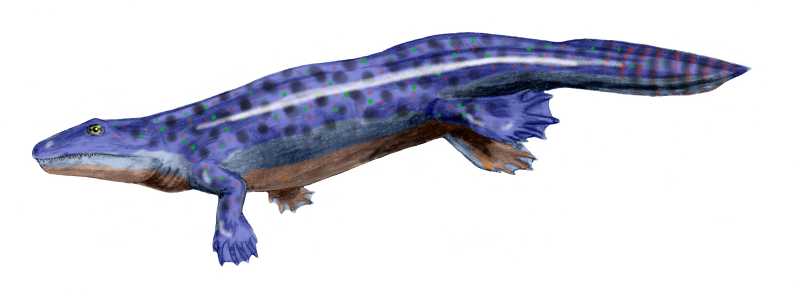- Ichthyostega
Taxobox
name = "Ichthyostega"
fossil_range = Fossil range|367|362.5Famennian (LateDevonian )

image_width = 250px
image_caption = Life restoration of "Ichthyostega" after Ahlberg, 2005.
regnum =Animal ia
phylum = Chordata
superclassis =Tetrapoda
ordo = Ichthyostegalia
familia = Ichthyostegidae
genus = "Ichthyostega"
genus_authority = Säve-Söderbergh, 1932
subdivision_ranks = Species
subdivision = "I. stensioei"
"I. watsoni"
"I. eigili"
"I. kochi""Ichthyostega" (Greek: "fish roof") is an early
tetrapod genus that lived in the UpperDevonian (Famennian ) period, 367-362.5 million years ago that represents an intermediate form betweenfish andamphibia ns. "Ichthyostega" possessed lungs and limbs that helped it navigate through shallow water inswamp s. Though sometimes referred to as an "amphibian", it is not considered a true member of the group, as the first true amphibians appeared in theCarboniferous period.History and systematics
In 1932
Gunnar Säve-Söderbergh described four "Ichthyostega" species from the Upper Devonian of EastGreenland and one species belonging to the genus "Ichthyostegopsis", "I. wimani". These species could be synonymous (in which case only "I. stensioei" would remain), because their morphological differences are not very pronounced. The species differ in skull proportions, skull punctuation and skull bone patterns. The comparisons were done on 14 specimens collected in 1931 by the Danish East Greenland Expedition. Additional specimens were collected between 1933 and 1955.The genus is closely related to "Acanthostega gunnari", also from East Greenland. "Ichthyostega"'s skull seems more fish-like than that of "Acanthostega", but its
girdle (shoulder and hip) morphology seems stronger and better adapted to land-life. "Ichthyostega" also had more supportiverib s and strongervertebra e with more developed zygapophyses. The first tetrapods (who probably didn't walk on land) were "Elginerpeton " and "Obruchevichthys ".Characteristics
"Ichthyostega" was about convert|5|ft|m long and had seven digits on each hind foot. The exact number of digits on the hand is not yet known, but was probably about the same as on the foot. It had a fin containing fin rays on its tail.
Adaptations for land life
Early tetrapods like "Ichthyostega" and "Acanthostega" differed from animals like Crossopterygians (for instance "
Eusthenopteron " or "Panderichthys ") in their increased adaptations for life on land. Though Crossopterygians possessedlung s, they usedgill s as their primary means of acquiringoxygen ; "Ichthyostega" appears to have relied on its lungs as its primary apparatus for breathing. Theskin of early tetrapods, unlike that ofCrossopterygian s, helped retain bodily fluids and deterdesiccation Crossopterygians used theirbody andtail for locomotion and theirfin s for balance; "Ichthyostega" used its limbs for locomotion and its tail for balance." – exhibited a sequence of adaptations:
- "
Panderichthys ", suited to muddy shallows; - "
Tiktaalik " with limb-like fins that could take it onto land; - Early tetrapods in weed-filled swamps, such as:
- "
Acanthostega " which had feet with eight digits, - "Ichthyostega" with limbs.
- "
coelacanth species.]The size of an adult "Ichthyostega" (1.5 m or 4 ft) precluded much completely terrestrial locomotion. Juveniles, though, could have moved about on land much more easily. The massive ribcage, though. was made up of overlapping ribs and the creatures possessed a stronger skeletal structure, a more rigid spine, and forelimbs apparently powerful enough to pull the body from the water. These anatomical modifications clearly evolved to handle the lack of buoyancy experienced on land. The hindlimbs were smaller than the forelimbs and unlikely to have born full weight in an adult.
Jennifer A. Clack suggests that "Ichthyostega" and its relatives spent time basking in the sun to raise their body temperatures, much as some animals do today: theMarine Iguana s on theGalapagos Island, seals or theGharial . They would have returned to the water to cool themselves, hunt for food and reproduce. In that case, they would need strong forelimbs to pull at least their anterior part out of the water, and a stronger ribcage and spine to support them while sunbathing on their abdomen like moderncrocodile s. The greater mobility of juveniles on land would have helped them avoid aquatic predators.Water was also still a requirement, because the
gel -like eggs of the earliest terrestrial tetrapods couldn't survive out of water, soreproduction could not occur without it. Water was also needed for their larvae and externalfertilization . Most land-dwelling vertebrates have since developed two methods of internal fertilization; either direct as seen in allamniote s and a few amphibians, or indirect for manysalamander s by placing aspermatophore on the ground which then is picked up by the female salamander.Ichthyostegoids ("
Elginerpeton ", "Acanthostega ", "Ichthyostega", etc.) were "succeeded" bytemnospondyl s andanthracosaur s, such as "Eryops ", an amphibian that truly developed the ability to walk on land. There is a gap of 20-30 million years between both groups. This gap, a classic invertebrate paleontology , is known asRomer's Gap , after the American paleontologistAlfred Sherwood Romer . In 2002 a 350 million year old fossil named "Pederpes finneyae " was found.See also
*
Prehistoric amphibian
*Prehistoric life
*List of transitional fossils
* "Hynerpeton "External links
* [http://tolweb.org/tree?group=Ichthyostega_stensioei&contgroup=Terrestrial_Vertebrates Excellent site on early tetrapods]
* [http://www.bio.miami.edu/tom/bil160/bil160goods/20_verts2.html Course site]
* [http://ijolite.geology.uiuc.edu/00FallClass/geo143/lect/lect12.html Course site]
* [http://www.livescience.com/animalworld/050831_four_legs.html First Four-Legged Animals Inched Along]
* [http://www.scientificamerican.com/print_version.cfm?articleID=000DC8B8-EA15-137C-AA1583414B7F0000 "Getting a Leg Up on Land"] "Scientific American" Nov. 21, 2005, article byJennifer A. Clack .References
*Blom, H. (2005) — Taxonomic Revision Of The Late Devonian Tetrapod Ichthyostega from East Greenland. "Palaeontology", 48, Part 1:111–134
*Westenberg, K. (1999) — From Fins to Feet. "National Geographic", 195, 5:114–127- "
Wikimedia Foundation. 2010.
